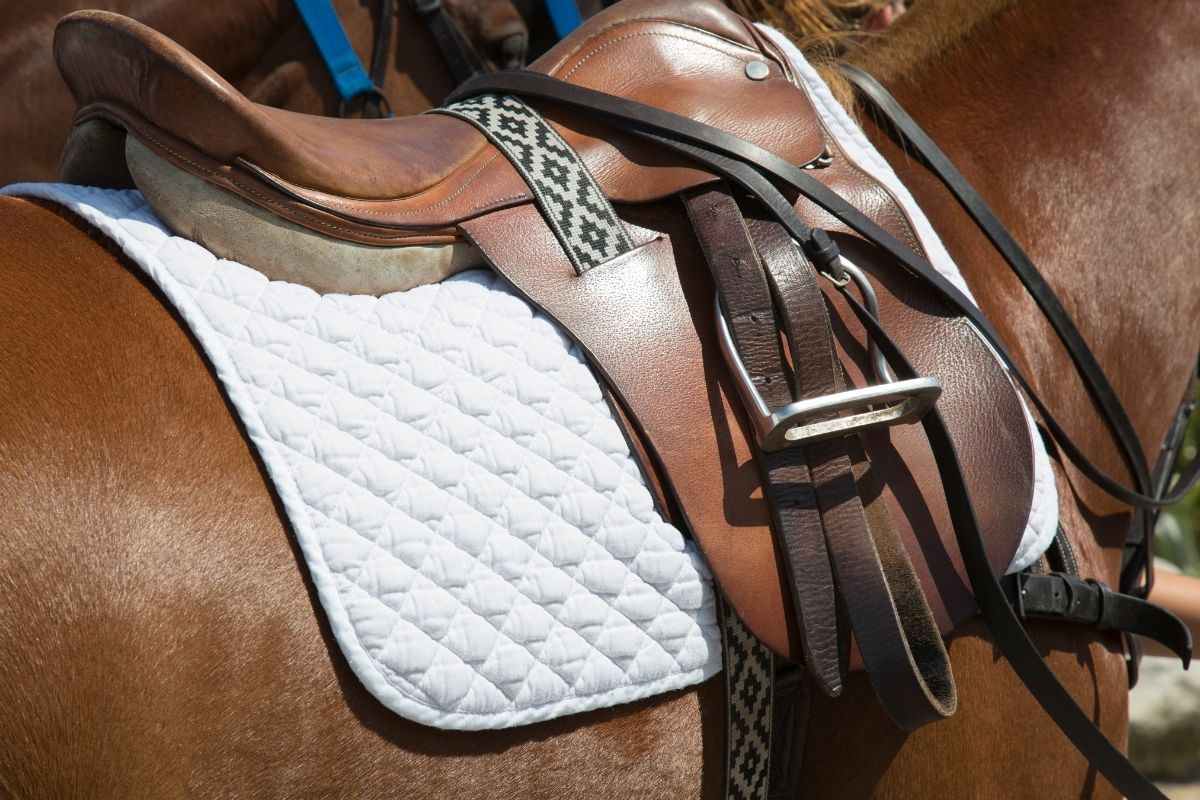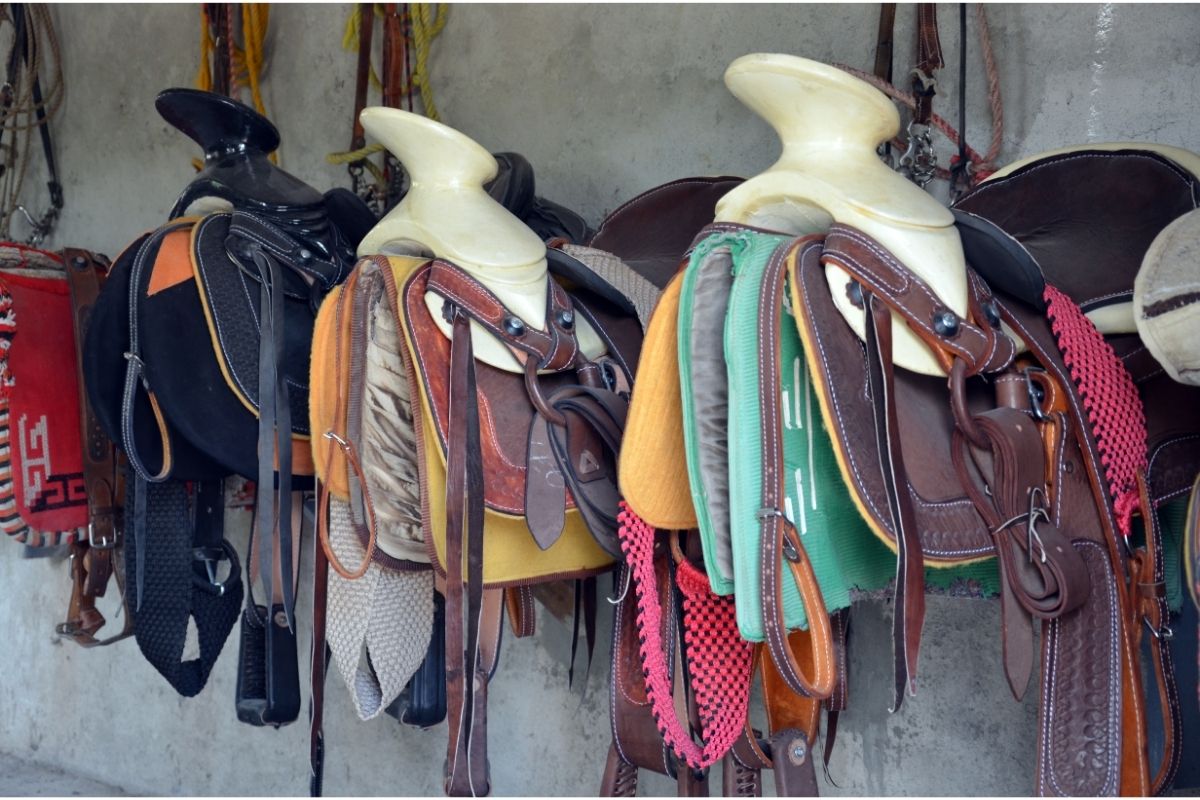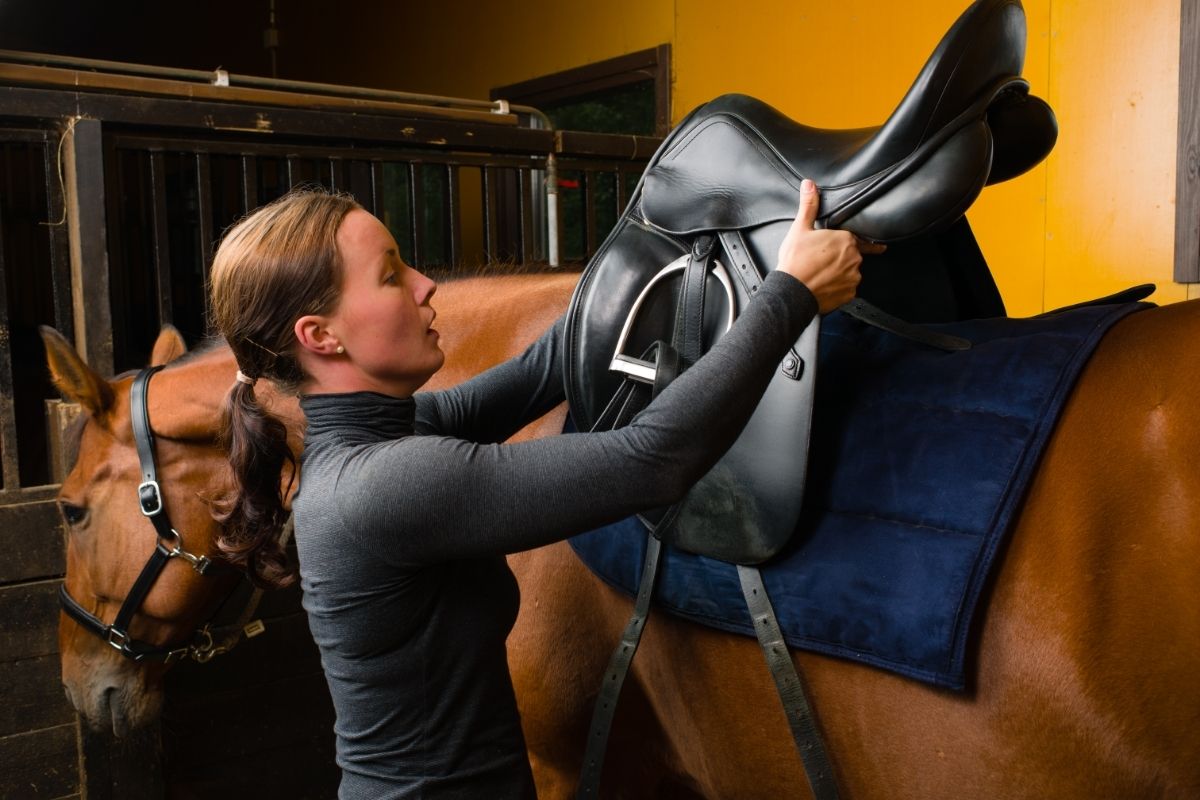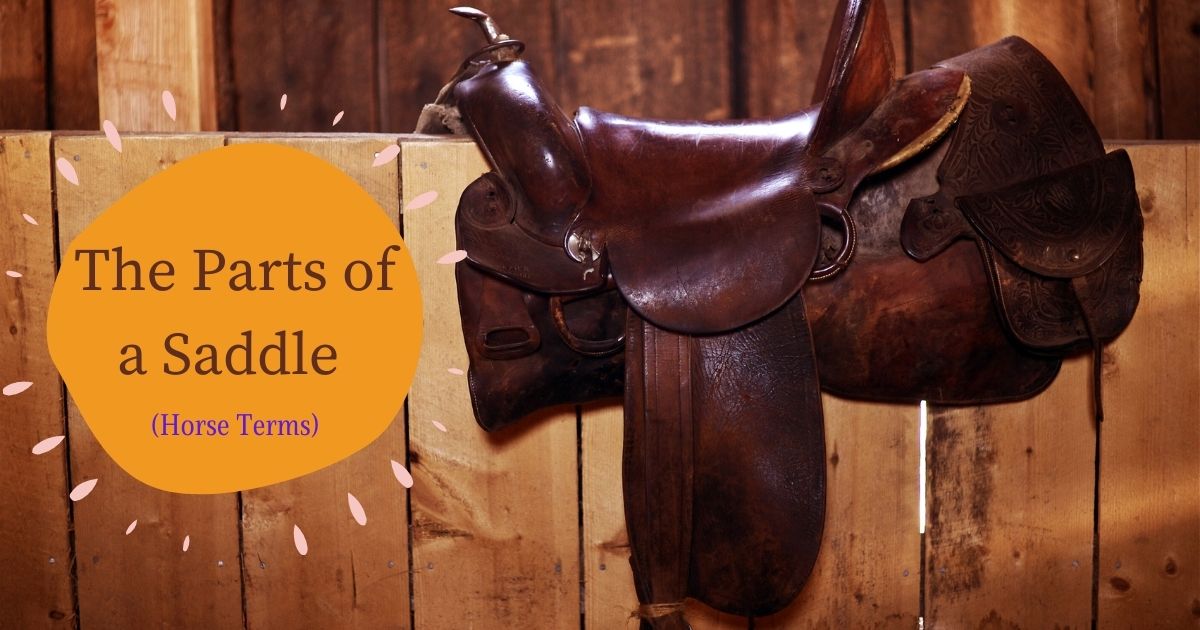Do you think it is obvious to have a saddle on your horse? Are you curious to know the parts of a saddle? Sometimes, the resultant convenience you get when using a saddle when riding a horse can override the need to learn any saddle part.
If you are guilty of overlooking what makes up your saddle, or you need to further your knowledge, let us get into the quest together.

Saddles and Horses Go Together!
A saddle leads in the list of the vital equipment you use on your horse. A saddle helps to distribute your weight correctly on the back of your horse. The move matches your center of gravity to the one of your horse. So, you cannot fall off your horse when using a saddle.
A saddle also helps you mount your horse with ease. It also makes it easy for you to lead your horse. So, it is a connection between yourself and your horse. A saddle helps you to communicate with your horse. So, using a tackle is a safe practice to adopt when riding your horse.
If you use a properly-fitted saddle, it prevents the back of your horse from injuries. In addition, the components of a horse saddle are usually proportional to the anatomical shapes of the rider and their horse. So, using a saddle gives you and your horse a passionate and pleasant ride.
A horse always reacts to the communication signals from its rider. One of the communication signals is the balance of a rider on the saddle of a horse. Other signals come from natural aids, including hands and calves.
The level of discipline of your horse determines the structure of the saddle that you will use when riding. The saddle should always communicate valid information to your horse. So, the performance and reaction of your horse is its feedback to your communication signals.
The performance quality of your horse depends on the validity of the instructions you give to your horse. If the performance is high, your signals are precise. Also, the design quality of the saddle determines the level of synchronization and fluency of horse movements.
Lastly, the design of particular elements of a saddle allows you to make adjustments that will match the level of the discipline of your horse. Also, you can adjust the saddle to meet your individual needs.
The History of the Saddle
You can be a pro in securing a saddle on the back of your horse. You can also be an expert in choosing the best-fitting saddle for your horse. Do you also give recommendations on the best saddle vendor? We bet you are generous to that extent. However, do you know the history of this good-to-have equipment for all horse riders?
Some people believe that a blanket with a girth-length material was the first saddle riders used on a horse. Such a belief is close to reality because early people could have gotten tired of clothes that wore out during a horse ride and light skin pain when riding a horse. Such consequences could have prompted the early riders to look for a solution.
True to the belief, some riders still use a blanket as a saddle for their horses, especially those that ride bare. But unfortunately, such people ignore the pain that results from the contact of human skin and horse fur.
Regarding the history of a saddle, humans rode their horses bare before the invention of saddles. The specific time is around 4000 BC. It is after the domestication of horses. The first recorded saddle consisted of pieces of cloth around 700 BC.
During those early times, horse riders added gold and jewelry to the cloth-made saddles. It was a show of their status. Others used elaborate details and unique showmanship on their cloth saddle to impress others.
Around 200 BC, the Chinese Han dynasty were the first people to create a saddle with a material-covered wooden frame. However, it was not as solid as the saddle the Romans from the West made. The Romanian saddle was the first to have four horns. It also had a wooden frame.
The saddle that the Romans made increased riding comfort significantly. Both the rider and their horse started enjoying the ride. The saddle prevented the pelvic bones of a rider from pressing the horseback. Also, the saddle distributed the rider’s weight evenly on the back of a horse.
The Romanian saddle also introduced the use of stirrups. Before the Romanian design, it was impossible to use stirrups. Any attempt to use them would concentrate pressure on the sides of a horse. So, the invention of the Roman design was a significant milestone in the development of horse saddles.
According to saddle specialists, the Eurasian nomads from Northern Iran invented what closely looks like the modern saddle around 500 BC. The saddle was the first to have a frame and other details that made it more solid. The details included leather thongs, cantles, girths, and cruppers.
After Iran’s nomadic invention of a saddle, other communities followed suit. First, however, they had to maintain the design of the saddle because the structure of horses remained the same. Other elements that remained the same were the comfort and security needed when riding a horse.
In the Middle Ages, warriors needed to improve the saddles that existed. They needed a saddle that could be more comfortable during a war. The saddle was also to withstand the weight of the weapons and armor. To the warriors, the regular saddle was useless.
So, the regular saddle required a higher pommel and cantle. The elements were to increase the security of the rider during a war. The saddle also needed stronger wood to tolerate heavier weight than the regular saddle.
Over time, cowboys and dressage riders required a unique saddle design. So, they decided to introduce a saddle with three points. Other cultures also continued to make improvements of their saddles to what is now their modern design.
Also, riders that needed to jump off their saddles had to lower the height of the pommel and cantle to allow more movement. The jumping riders also created a flap that could enable them to lean closer to their horses during a jump.
The Three Main Parts of a Horse Saddle
The saddle of a horse has three main parts besides other elements. The main parts are the cantle, the seat, and the pommel. You can think of them as the leading English saddle parts that form the back, the middle, and the front of a saddle.
The Cantle
The cantle is the back part of a saddle. It slopes upwards to support the rider perfectly. Also, it is wider than the other two parts of a saddle. Interestingly, the cantle is the determinant of the types of saddles.
When the cantle is high, the saddle achieves a deep seat. On the other hand, a low cantle creates close contact between a rider and a horse. Sometimes, saddle enthusiasts adorn silver or brass plates on the cantle of their saddles.
The Seat
This part of a saddle is where you sit when riding your horse. It features foam padding that enhances comfort. It also has main flaps on each side. The flaps support the legs of a rider. Lastly, the seat connects with the girth and stirrup leathers.
Regarding the main flaps, there are duo or mono flaps. A duo-flap features two flaps. Also, some billets connect the saddle to the girth under one flap.
A mono-flap consists of one flap with billets underneath—however, the billets of a mono-flap support a shorter girth than a duo-flap supports.
The Pommel
The front part of your saddle is the pommel. It slopes upwards to a few inches and rises above the withers of your horse. Its core function is to position a rider on the seat properly. A saddle pommel also supports the knees of a rider. It has knee pads or flaps.

Saddle Attachments and Their Functions
An English saddle cannot function properly without the support of various attachments. The following are the additional parts of an English saddle:
Stirrup Leathers
Stirrup leathers are straps that connect the saddle to the stirrups. You can find them on the seat of a saddle. They are also adjustable to accommodate various heights of the riders’ legs.
Stirrups
Stirrups are metal attachments that support the feet of a horse rider. They contribute to the stability and the balance of a rider as they sit on a saddle. The following are various types of Stirrups:
- Spiked stirrups for enhanced grip.
- Extra-jointed stirrups for enhanced mobility.
- Plastic stirrups
Grab and Croup Strap
You can find saddles with D-rings that support the attachment of grab or croup straps. A grab strap refers to a small leather strap that runs from the ends of the pommel. It helps horse riders use their hands to enhance their stability when riding a horse.
A grab strap is one of the parts of a dressage saddle. Also, trainers use them when teaching hand position and balance to new and young riding trainees.
Regarding the croup strap, it runs from each end of the cantle. It also runs around the tail of a horse. It prevents the saddle from sliding upwards on the neck of a horse.
Girth
A girth ties a saddle in place on the back of a horse. It runs around the belly of a horse. You can find leather, rubber, synthetic, runner, and rope girths. Also, you can find thin girths that make a saddle look small. Their function is to shift the focus from the saddle to the horse. The hunter ring usually employs thin girths.
Wide girths include leather girths found on jumper rings. They cover the belly of a horse completely. Their function is to protect the belly of a horse from hoof-related injuries. Often, jumping horses kick their bellies with hooves when jumping a rail.
Breastplate and Martingale
A breastplate holds a saddle in place to prevent backward sliding. You can find it in almost any ring. Breastplates are either eventing five-point or standard three-point.
The standard three-point breastplate connects with the saddle three-way. Firstly, it relates to the girth. Secondly, it connects to the pommel two times. On the other hand, a five-point breastplate connects two times to the pommel, two times to the billets, and once to the girth.
Regarding martingale, it rests on a horse’s neck and runs from the girth. A horse with a martingale cannot throw its head too high up. Such a move is dangerous to the horse and its rider.
A martingale has a running or standing design. A running martingale connects to a breastplate or martingale neckpiece. Its two straps connect to the bridle reins. A standing martingale is all-leather. It attaches the girth to the bridle of a horse.
Uses and Parts of a Western Saddle
Different cultures have different designs of horse saddles. So, the Western saddle has additional elements that an English saddle does not have. The following are the Western saddle parts:
Swells/Fork/Pommel
Swells or Fork is the front upper raised part of a fork saddle. The Westerners have given it additional names instead of referring to it as a pommel.
Horn
A horn is a feature that makes a Western saddle unique. Its well-known purpose is to secure a rope tied to an animal that the rider guides, such as a cow or a calf. However, a rider can also hold onto a horn when dismounting or mounting a horse. Also, the rider can hang a pommel saddle bag on the horn.
In the Western riding world, there are several types of saddle horns. Each horn comes with the unique convenience that it provides to its user. The following are some of the popular horns that you can find on saddles:
- Number one horn: This is the most popular saddle horn that almost everyone uses. It has a low profile that does not interfere with your reins. Its forward-tilting design keeps it out of your way as you ride. So, you only use it when you need it.
- Post or dally: This horn is slightly taller than the number one horn. Also, it has a big cap and a vertical design. It is for a roping saddle. Lastly, it has a rubber wrapper to prevent your rope from slipping from the horn.
- Cow horse or cutting: This horn keeps you safe when your horse jumps during athletics. It has an optimal tilt that keeps your elbow away from your hip. A rider holds it with three fingers below its cap, the index finger at the front part of the cap, and the thumb around the horn. So, the heel of the hand pushes against the horn for balance.
Seat
A Western saddle seat is similar to the English saddle seat. It is the part of a saddle where a rider sits.
Cantle
The cantle of a Western saddle also has a similar purpose to the cantle of an English saddle. A cantle is the back part of a saddle. It prevents a rider from slipping backward from the seat of a saddle.
Latigo
A saddle Latigo is a leather or nylon strap. It secures the front cinch to a horse. In its absence, the front cinch can keep on slipping to the under-belly of a horse when the horse is in motion.
Latigo Keeper
A Latigo keeper is a horizontally slotted small tab. It helps to hold the extra length of a Latigo. Without a Latigo keeper, a Latigo can get mangled up with other attachments of a Western saddle.
Back Jockey/Seat Jockey
A seat jockey helps to cover the attachments under a saddle seat. You can also refer to it as back housing. It is a seat cover that makes a Western saddle appear neat. If you see a saddle without a seat jockey, the motive of a rider is to minimize the attachments of a saddle and cut back the weight of the saddle.
Skirt
The other name of the skirt is a saddle skirt. It is a cover that riders attach to the saddle tree. A skirt runs down both sides of a horse. Lastly, its underside has a sheepskin lining.
Stirrup Fender
You can either call it a fender or a stirrup fender. It is a wide flap that connects the saddle with the stirrups.
Stirrup Hobble
A stirrup hobble is a strap that fastens the stirrups to the stirrup fender. It holds the stirrups from their upper side. Failure to use a stirrup hobble can make a stirrup slip out of its position to move up the stirrup fender.
Stirrup
A stirrup is a metallic or plastic ring where a rider puts their foot when sited on a saddle. In other words, it is a saddle footrest.
Marker’s Mark
A saddle maker puts a marker’s mark on a saddle as an identifying stamp. However, some tackles do not feature the mark. For example, you can spot the marker’s mark on the Latigo keeper, stirrup fender, or stirrup hobble. The positioning of the mark depends on the preference of the saddle maker.
Front Cinch
A front cinch is a strap found underneath the chest of a horse. On its right side, it connects to the saddle using a billet. On its left side, it attaches to the saddle using a Latigo.
Flank Billet/Back Billet
A flank billet is a strap that droops on the sides of a horse. It connects to the back of a saddle using the back cinch.
Flank Cinch/Back Cinch
A back cinch is a strap that runs underneath the back belly of a horse. It connects with the back jockey using back billets. Its function is to keep the back of the saddle fastened to the back of the horse when a horse ropes or rides on uneven ground.
Cinch Connector Strap
A cinch connector strap is a small strap that connects the front cinch to the back cinch. Failure to use a cinch connector strap can make the back cinch slide backward and make a horse buck or spook.
Breast Collar
A breast collar accompanies a saddle rather than being one of its parts. It attaches to the front part of a saddle to prevent the saddle from sliding backward. It also helps keep a saddle upright when a horse tips to the side.

The Final Neigh
Now that you have all this information about the parts of a horse tack, you will no longer take it for granted. Also, you can identify what is missing on your horse saddle and get to improve the comfort of your saddle. So, go ahead and inspect your saddle now.
